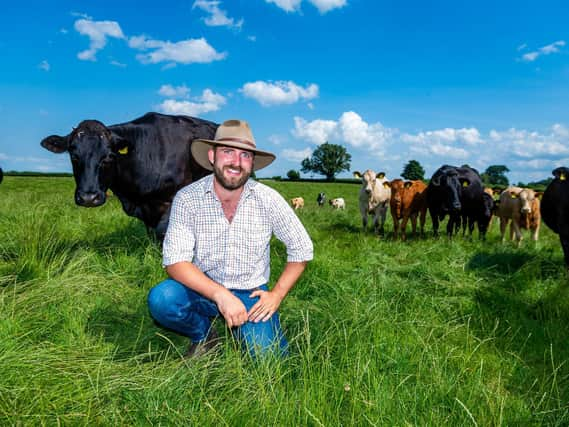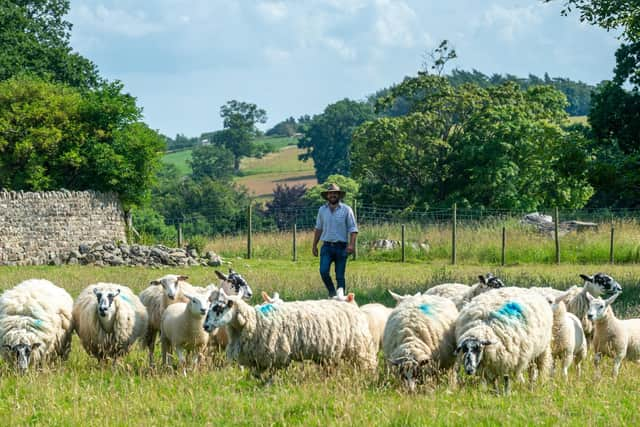Farm of the Week: Regenerative farming near Ripon overseen by a new generation keen to fight climate change


James Johnson farms at Mallard Grange, Aldfield, near Ripon, where the tenanted mixed farm he manages with his father, Charles, runs to 580 acres and includes beef livestock, sheep and 160 acres of arable cropping.
James said his studies at Harper Adams and his second-year work placement on much larger farms in Northamptonshire and Oxfordshire opened his eyes.
Advertisement
Hide AdAdvertisement
Hide Ad“I’m now also a firm believer in regenerative farming. It is all about looking after the soil. Instead of looking at sustainability, which is to my mind only about maintaining where we’re at, we need to be able to bring back that carbon into the soil that we as farmers have been releasing.


“Farmers have taken soil for granted for a long time. Since I have come back to the farm and having joined organisations like Future Farmers of Yorkshire I have learned a huge amount more about what we need to do and how it can be beneficial to take the regenerative approach, especially as our climate continues to change.”
In May this year James attended the Groundswell Show and Conference in Hertfordshire, which concentrates on regenerative farming highlighting the improvement of soil health through conservation methods, cover crops, no-till and bringing back livestock into an arable farm. He and his father are already committed to this, but James said it was refreshing to talk with others.
“My father’s great, because he’s not afraid of change. As long as I’ve been able to prove what I’ve been doing he’s been open to ideas. Our farm is a mixture of my young enthusiasm and his experience. As a team, especially with my mum Maggie involved as well, we are a really strong unit. We’ve been looking at new ideas and that’s how growing lucerne and going more forage based has come about.
Advertisement
Hide AdAdvertisement
Hide Ad“Our livestock enterprise is now going all grass fed and getting to the stage where we use no concentrates whatsoever. Everybody has different opinions on feeding. Some are tempted to use grains to get animals away quicker. We believe using grass is better and more healthy.
“We are now improving the carbon sequestration through cover crops and we are looking at going into herbal leys. We are trying to develop biodiversity and we need to make sure we conserve moisture in the soil.”
James and Charles’ cropping this year includes 60 acres of winter wheat varieties Skyscraper and Kerrin; 35 acres of winter barley Gimlet; 26 acres of oats; 24 acres of spring beans variety Fuego; 11 acres of lucerne plus cover crops with most crops grown for feed. They have also opted for direct drilling and have purchased a second-hand Sumo Versadrill.
The livestock operation includes 400-head of cattle on the farm by some point each year, with a suckler herd of 75 cows plus a herd of 75 calving heifers bringing about around 150 new-born calves a year.
Advertisement
Hide AdAdvertisement
Hide AdJames said the beef breeding heifer replacement programme they have adopted is different to the norm.
“We have an arrangement with a local dairy farm where we nominate the Limousin sire that goes on his older cows and we take all of the heifer calves from those at 12 weeks and rear them on.
“We calve them down at between two to two and a half years old with either a Limousin or a Blonde. We then keep so many, sell so many. We now have a lot of people who buy from us either from the farm or at such as our local mart at Pateley Bridge where the auctioneer Libby Bell does a wonderful job.”
He added: “We are looking at cattle breeds that do better off grass rather than grains and soya, and it’s better for the environment.”
Advertisement
Hide AdAdvertisement
Hide AdThe sheep also fit well into the new systems at Mallard Grange, although James said he wasn’t greatly enamoured with them originally on his return from Harper.
“We had 450 ewes and at the time I just wanted them to go, but we’ve just reintroduced them and now have 100 Lleyns and 50 Mules.”
James’ mum Maggie also runs a bed and breakfast enterprise of four rooms and Airbnb accommodation. James came back from his work placement with a hive of bees in his car. Today the farm has six hives and honey is made and available in Maggie’s breakfasts.
James said he is totally behind all aspects of regenerative farming.
Advertisement
Hide AdAdvertisement
Hide Ad“The great thing about regenerative farming is that it fuels my passion. We saw a change within three months of taking our new approach on board. Growing a polyculture of cover crops including two types of stubble turnips, tillage radish, fodder radish, crimson clover and vetch, which we drilled in July last year, by October we could see how much good it was doing aesthetically and on the ground and to wildlife.
“The fodder radish was flowering and full of insects, the birds were winging across the top eating off insects. You looked at the bottom and it was full of spiders and life, feeding all that diversity.
“When the sheep go on it’s their own all you can eat buffet. Little birds can use the small seeds for winter. You get such a good feeling that you’ve not just fed our sheep and done a really good job of reconstituting the soil, you’ve also fed the birds and insects. Every time I’ve been in there, I can’t help but smile.
“I feel that a regenerative farming programme is something you can feel proud of. Something where you feel you are doing some good.
“I want to be successful, I don’t like being the norm. I’m the guy that maybe goes to a do in coloured chinos.”